Announcement: Chapter quizzes are not working as of summer 2023.
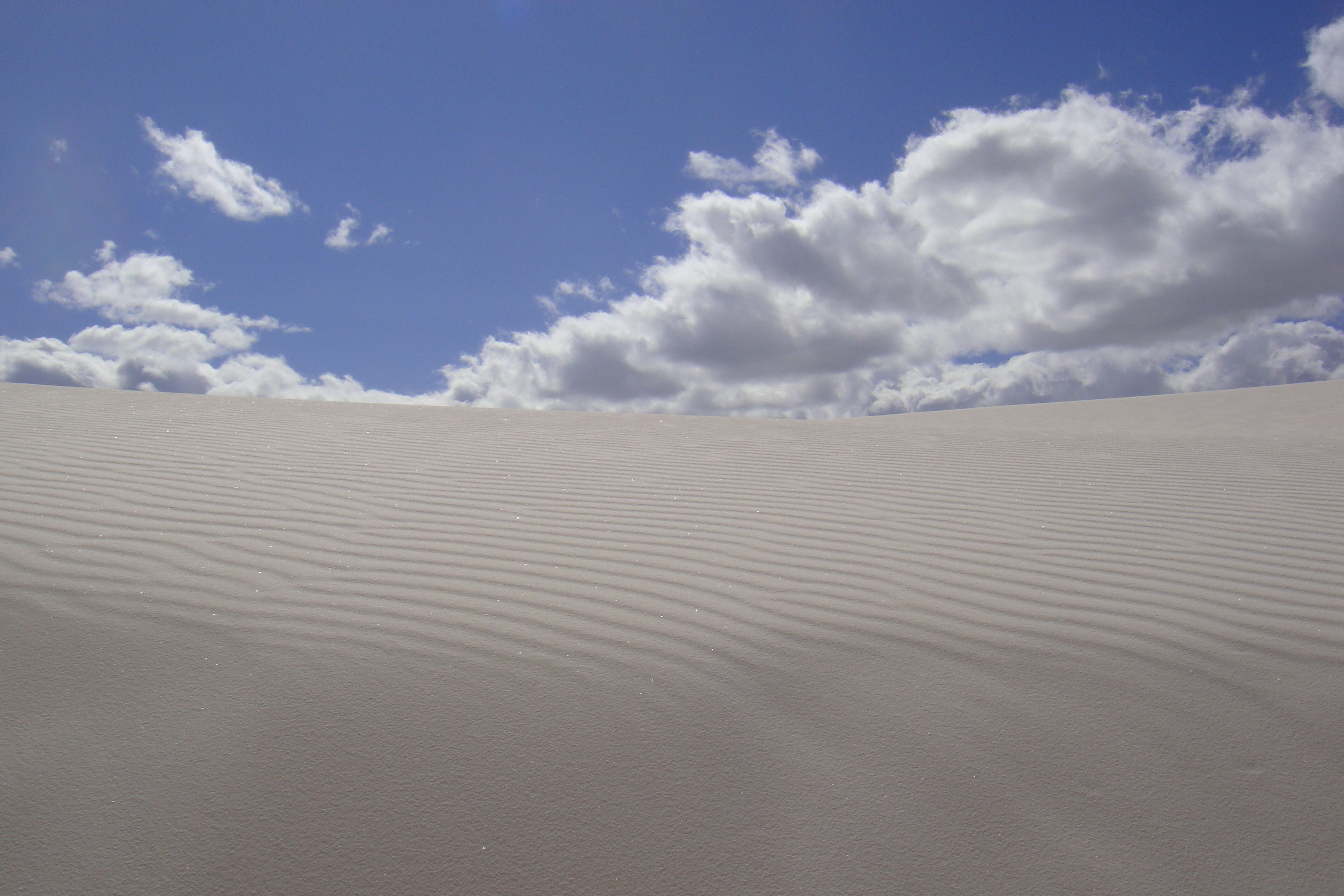
13 Deserts
KEY CONCEPTS
By the end of this chapter, students should be able to:
- Explain the defining characteristic of a desert and distinguish between the three broad categories of deserts
- Explain how geographic features, latitude, atmospheric circulation, and Coriolis Effect influence where deserts are located
- List the primary desert weathering and erosion processes
- Identify desert landforms
- Explain how desert landforms are formed by erosion and deposition
- Describe the main types of sand dunes and the conditions that form them
- Identify the main features of the Basin and Range desert (United States)
![By Koppen_World_Map_Hi-Res.png: Peel, M. C., Finlayson, B. L., and McMahon, T. A.(University of Melbourne)derivative work: Me ne frego (Koppen_World_Map_Hi-Res.png) [<a href="http://creativecommons.org/licenses/by-sa/3.0">CC BY-SA 3.0</a>], <a href="https://commons.wikimedia.org/wiki/File%3AKoppen_World_Map_BWh.png">via Wikimedia Commons</a> The hot deserts are all near 30 north or south latitude.](https://opengeology.org/textbook/wp-content/uploads/2016/07/Koppen_World_Map_BWh-300x184.png)
![By en:User:Bariot (en:File:Rainshadow copy.jpg) [Public domain], <a href="https://commons.wikimedia.org/wiki/File%3ARainshadow_copy.jpg">via Wikimedia Commons</a> There is a dry and wet side to the mountain due to air movement.](https://opengeology.org/textbook/wp-content/uploads/2016/07/Rainshadow-300x169.jpg)
![Source: By Picture prepared for Wikipedia by Adrian Pingstone in November 2003. (NASA) [Public domain], <a href="https://commons.wikimedia.org/wiki/File%3AOwens.lake.arp.750pix.jpg">via Wikimedia Commons</a> There are several ranges, some more snowy than others.](https://opengeology.org/textbook/wp-content/uploads/2016/07/OwensLake-300x300.jpg)
Finally, polar deserts, such as vast areas of the Antarctic and Arctic, are created from sinking cold air that is too cold to hold much moisture. Although they are covered with ice and snow, these deserts have very low average annual precipitation. As a result, Antarctica is Earth’s driest continent.
13.1 The Origin of Deserts
13.1.1 Atmospheric circulation
Geographic location, atmospheric circulation, and the Earth’s rotation are the primary causal factors of deserts. Solar energy converted to heat is the engine that drives the circulation of air in the atmosphere and water in the oceans. The strength of the circulation is determined by how much energy is absorbed by the Earth’s surface, which in turn is dependent on the average position of the Sun relative to the Earth. In other words, the Earth is heated unevenly depending on latitude and angle of incidence. Latitude is a line circling the Earth parallel to the equator and is measured in degrees. The equator is 0° and the North and South Poles are 90° N and 90° S respectively (see the diagram of generalized atmospheric circulation on Earth). Angle of incidence is the angle made by a ray of sunlight shining on the Earth’s surface. Tropical zones are located near the equator, where the latitude and angle of incidence are close to 0°, and receive high amounts of solar energy. The poles, which have latitudes and angles of incidence approaching 90°, receive little or almost no energy.
![Source: This file is in the public domain in the United States because it was solely created by NASA. NASA copyright policy states that "NASA material is not protected by copyright unless noted". (See Template:PD-USGov, NASA copyright policy page or JPL Image Use Policy.)Warnings:Use of NASA logos, insignia and emblems is restricted per U.S. law 14 CFR 1221.The NASA website hosts a large number of images from the Soviet/Russian space agency, and other non-American space agencies. These are not necessarily in the public domain.Materials based on Hubble Space Telescope data may be copyrighted if they are not explicitly produced by the STScI.[1] See also {{PD-Hubble}} and {{Cc-Hubble}}.The SOHO (ESA & NASA) joint project implies that all materials created by its probe are copyrighted and require permission for commercial non-educational use. [2]Images featured on the Astronomy Picture of the Day (APOD) web site may be copyrighted. [3]The National Space Science Data Center (NSSDC) site has been known to host copyrighted content even though its photo gallery FAQ states that all of the images in the photo gallery are in the public domain. [Public domain], <a href="https://commons.wikimedia.org/wiki/File%3AEarth_Global_Circulation.jpg">via Wikimedia Commons</a> An illustration of the earth with three generalized circulation cells shown for each hemisphere.](https://opengeology.org/textbook/wp-content/uploads/2016/07/01-Earth_Global_Circulation-300x257.jpg)
![By C.E. Soulard, USGS [Public domain], <a href="https://commons.wikimedia.org/wiki/File%3ACentral_Basin_and_Range_ecoregion.png">via Wikimedia Commons</a> The area covers most of Nevada, easternmost California, southern Idaho, and western Utah.](https://opengeology.org/textbook/wp-content/uploads/2016/07/Central_Basin_and_Range_ecoregion-300x264.png)
![By cobaltcigs [<a href="http://creativecommons.org/licenses/by-sa/3.0">CC BY-SA 3.0</a> or <a href="http://www.gnu.org/copyleft/fdl.html">GFDL</a>], <a href="https://commons.wikimedia.org/wiki/File%3AAtacama_map.svg">via Wikimedia Commons</a> It is in west-central South America](https://opengeology.org/textbook/wp-content/uploads/2016/07/Atacama_map.svg_-214x300.png)
![Source: By National Oceanic and Atmospheric Administration - Pacific Marine Environmental Laboratory [Public domain], <a href="https://commons.wikimedia.org/wiki/File%3ANovember2013_polar_vortex_geopotentialheight_mean_Large.jpg">via Wikimedia Commons</a> The sinking air is centered just north of Greenland, close to the north pole.](https://opengeology.org/textbook/wp-content/uploads/2016/07/polar_vortex-277x300.jpg)
13.1.2 Coriolis Effect
![Solurce: By Hubi (German Wikipedia) [<a href="http://www.gnu.org/copyleft/fdl.html">GFDL</a> or <a href="http://creativecommons.org/licenses/by-sa/3.0/">CC-BY-SA-3.0</a>], <a href="https://commons.wikimedia.org/wiki/File%3ACorioliskraftanimation.gif">via Wikimedia Commons</a> Animation illustrating a ball thrown on a rotating disc from the center to the edge. Viewed from the perspective of a stationary viewer on the disc, it appears to follow a curved path.](https://opengeology.org/textbook/wp-content/uploads/2016/07/13.2_Corioliskraftanimation.gif)
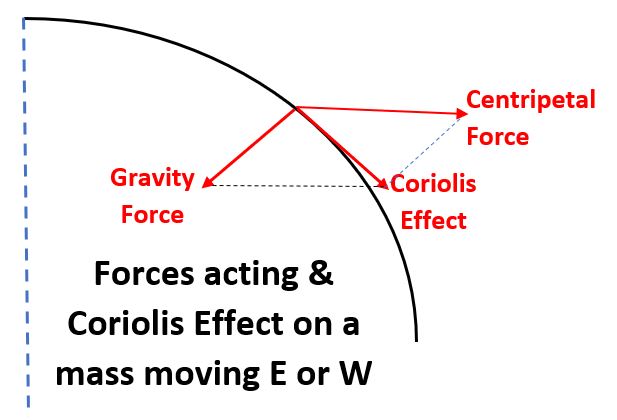
Another factor in the Coriolis effect also causes deflection of east-west movement due to the angle between the centripetal effect of Earth’s spin and gravity pulling toward the earth’s center (see figure). This produces a net deflection toward the equator. The total Coriolis deflection on a mass moving in any direction on the rotating Earth results from a combination of these two factors.
Since each hemisphere has three atmospheric cells moving respectively north and south relative to the Earth beneath them, the Coriolis effect deflects these moving air masses to the right in the Northern Hemisphere and to the left in the Southern Hemisphere. The Coriolis effect also deflects moving masses of water in the ocean currents.
For example, in the northern hemisphere Hadley Cell, the lower altitude air currents are flowing south towards the equator. These are deflected to the right (or west) by the Coriolis effect. This deflected air generates the prevailing trade winds that European sailors used to cross the Atlantic Ocean and reach South America and the Caribbean Islands in their tall ships. This air movement is mirrored in the Hadley Cell in the southern hemisphere; the lower altitude air current flowing equatorward is deflected to the left, creating trade winds that blow to the northwest.
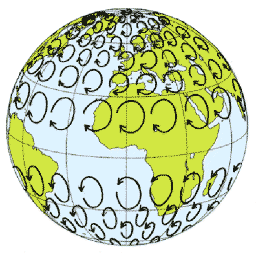
In the northern Mid-Latitude or Ferrel Cell, surface air currents flow from the horse latitudes (latitude 30°) toward the North Pole, and the Coriolis effect deflects them toward the east, or to the right, producing the zone of westerly winds. In the southern hemisphere Mid-Latitude or Ferrel Cell, the poleward flowing surface air is deflected to the left and flows southeast creating the Southern Hemisphere westerlies.
Another Coriolis-generated deflection produces the Polar Cells. At 60o north and south latitude, relatively warmer rising air flows poleward cooling and converging at the poles where it sinks in the polar high. This sinking dry air creates the polar deserts, the driest deserts on Earth. Persistence of ice and snow is a result of cold temperatures at these dry locations.
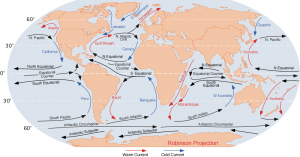
The Coriolis effect operates on all motions on the Earth. Artillerymen must take the Coriolis effect into account on ballistic trajectories when making long-distance targeting calculations. Geologists note how its effect on air and oceanic currents creates deserts in designated zones around the Earth as well as the surface currents in the ocean. The Coriolis effect causes the ocean gyres to turn clockwise in the northern hemisphere and counterclockwise in the southern. It also affects weather by creating high-altitude, polar jet streams that sometimes push lobes of cold arctic air into the temperate zone, down to as far as latitude 30° from the usual 60°. It also causes low pressure systems and intense tropical storms to rotate counter-clockwise in the Northern Hemisphere and clockwise in the Southern Hemisphere.
Explanation of Coriolis Effect.
[ays_quiz id=”82″]
13.2 Desert weathering and erosion
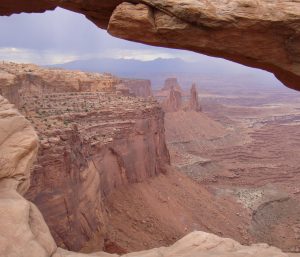
Weathering takes place in desert climates by the same means as other climates, only at a slower rate. While higher temperatures typically spur faster chemical weathering, water is the main agent of weathering, and lack of water slows both mechanical and chemical weathering. Low precipitation levels also mean less runoff as well as ice wedging. When precipitation does occur in the desert, it is often heavy and may result in flash floods in which a lot of material may be dislodged and moved quickly.
![Source: By Cacophony (Own work) [<a href="http://creativecommons.org/licenses/by-sa/3.0">CC BY-SA 3.0</a> or <a href="http://www.gnu.org/copyleft/fdl.html">GFDL</a>], <a href="https://commons.wikimedia.org/wiki/File%3ANewspaper_Rock_Full.jpg">via Wikimedia Commons</a> The rock is dark brown with petroglyphs](https://opengeology.org/textbook/wp-content/uploads/2016/07/Newspaper_Rock_Full-300x200.jpg)
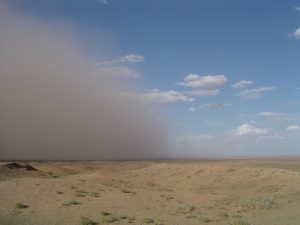
While water is still the dominant agent of erosion in most desert environments, wind is a notable agent of weathering and erosion in many deserts. This includes suspended sediment traveling in haboobs, or large dust storms, that frequent deserts. Deposits of windblown dust are called loess. Loess deposits cover wide areas of the midwestern United States, much of it from rock flour that melted out of the ice sheets during the last ice age. Loess was also blown from desert regions in the West. Possessing lower energy than water, wind transport nevertheless moves sand, silt, and dust. As noted in chapter 11, the load carried by a fluid (air is a fluid like water) is distributed among bedload and suspended load. As with water, in wind these components depend on wind velocity.
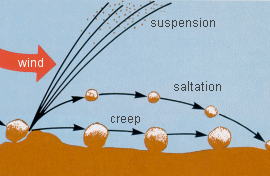 Sand size material moves by a process called saltation in which sand grains are lifted into the moving air and carried a short distance where they drop and splash into the surface dislodging other sand grains which are then carried a short distance and splash dislodging still others [zotpressInText item=”{J8N5GRPZ}” format=”%num%” brackets=”yes”].
Sand size material moves by a process called saltation in which sand grains are lifted into the moving air and carried a short distance where they drop and splash into the surface dislodging other sand grains which are then carried a short distance and splash dislodging still others [zotpressInText item=”{J8N5GRPZ}” format=”%num%” brackets=”yes”].
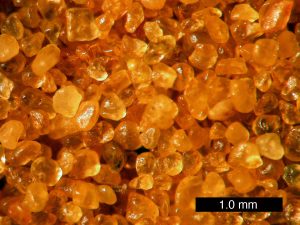
Since saltating sand grains are constantly impacting other sand grains, wind blown sand grains are commonly quite well rounded with frosted surfaces. Saltation is a cascading effect of sand movement creating a zone of wind blown sand up to a meter or so above the ground. This zone of saltating sand is a powerful erosive agent in which bedrock features are effectively sandblasted. The fine-grained suspended load is effectively sorted from the sand near the surface carrying the silt and dust into haboobs. Wind is thus an effective sorting agent separating sand and dust sized (≤70 µm) particles (See Chapter 5). When wind velocity is high enough to slide or roll materials along the surface, the process is called creep.
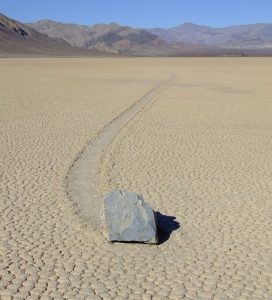 One extreme version of sediment movement was shrouded in mystery for years: Sliding stones. Also called sailing stones and sliding rocks, these are large moving boulders along flat surfaces in deserts, leaving trails. This includes the famous example of the Racetrack Playa in Death Valley National Park, California. For years, scientists and enthusiasts attempted to explain their movement, with little definitive results. In recent years, several experimental and observational studies have confirmed that the stones, imbedded in thin layers of ice, are propelled by friction from high winds. These studies include measurements of actual movement, as well as re-creations of the conditions, with resulting movement in the lab.
One extreme version of sediment movement was shrouded in mystery for years: Sliding stones. Also called sailing stones and sliding rocks, these are large moving boulders along flat surfaces in deserts, leaving trails. This includes the famous example of the Racetrack Playa in Death Valley National Park, California. For years, scientists and enthusiasts attempted to explain their movement, with little definitive results. In recent years, several experimental and observational studies have confirmed that the stones, imbedded in thin layers of ice, are propelled by friction from high winds. These studies include measurements of actual movement, as well as re-creations of the conditions, with resulting movement in the lab.
![Source: <a href="https://de.wikipedia.org/wiki/User:Thomas_Wilken" class="extiw" title="de:User:Thomas Wilken">Thomas Wilken</a> at the <a href="https://de.wikipedia.org/wiki/" class="extiw" title="de:">German language Wikipedia</a> [<a href="http://www.gnu.org/copyleft/fdl.html">GFDL</a> or <a href="http://creativecommons.org/licenses/by-sa/3.0/">CC-BY-SA-3.0</a>], <a href="https://commons.wikimedia.org/wiki/File%3AIm_Salar_de_Uyuni.jpg">via Wikimedia Commons</a> Large rock standing on a narrow base sandblasted by saltating sand blowing near the ground.](https://opengeology.org/textbook/wp-content/uploads/2016/07/13.7_Yardang_Im_Salar_de_Uyuni-300x223.jpg)
![Source: By Wilson44691 (Own work) [<a href="http://creativecommons.org/publicdomain/zero/1.0/deed.en">CC0</a>], <a href="https://commons.wikimedia.org/wiki/File%3AVentifactMojaveDesert031511.jpg">via Wikimedia Commons</a> Rock on desert floor polished on multiple sides by sandblasting by shifting winds.](https://opengeology.org/textbook/wp-content/uploads/2016/07/13.8_VentifactMojaveDesert031511-300x278.jpg)
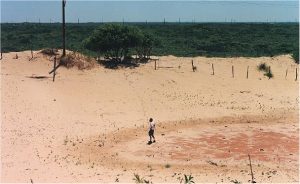
In places with sand and silt accumulations, clumps of vegetation often anchor sediment on the desert surface. Yet, winds may be sufficient to remove materials not anchored by vegetation. The bowl-shaped depression remaining on the surface is called a blowout.
[ays_quiz id=”83″]
13.3 Desert landforms
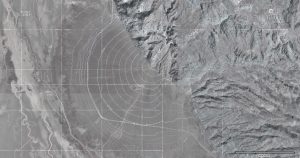
In the American Southwest, as streams emerge into the valleys from the adjacent mountains, they create desert landforms called alluvial fans. When the stream emerges from the narrow canyon, the flow is no longer constrained by the canyon walls and spreads out. At the lower slope angle, the water slows down and drops its coarser load. As the channel fills with this conglomeratic material, the stream is deflected around it. This deposited material deflects the stream into a system of radial distributary channels in a process similar to how a delta is made by a river entering a body of water. This process develops a system of radial distributaries and constructs a fan shaped feature called an alluvial fan.
![Source: <a href="https://de.wikipedia.org/wiki/User:GerthMichael" class="extiw" title="de:User:GerthMichael">GerthMichael</a> at <a href="https://de.wikipedia.org/wiki/" class="extiw" title="de:">German Wikipedia</a> [<a href="http://www.gnu.org/copyleft/fdl.html">GFDL</a>, <a href="http://creativecommons.org/licenses/by-sa/3.0">CC BY-SA 3.0</a> or <a href="http://creativecommons.org/licenses/by-sa/3.0/de/deed.en">CC BY-SA 3.0 de</a>], <a href="https://commons.wikimedia.org/wiki/File%3AFriscoMountainUT.jpg">via Wikimedia Commons</a> Photo of mountain where alluvial fans have coalesced into an apron of sedimant along the mountain front.](https://opengeology.org/textbook/wp-content/uploads/2016/07/13.11_Bajada_at_FriscoMountainUT-300x200.jpg)
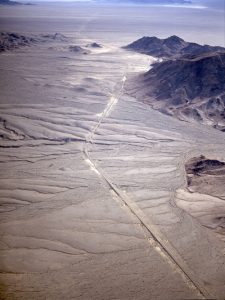
As the mountains erode away and their sediment accumulates first in alluvial fans, then bajadas, the mountains eventually are buried in their own erosional debris. Such buried mountain remnants are called inselbergs, “island mountains,” as first described by the German geologist Wilhelm Bornhardt (1864–1946).
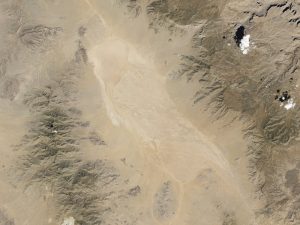
Where the desert valley is an enclosed basin, i.e. streams entering it do not drain out, the water is removed by evaporation and a dry lake bed is formed called a playa.
![Source: By Finetooth (Own work) [<a href="http://creativecommons.org/licenses/by-sa/3.0">CC BY-SA 3.0</a> or <a href="http://www.gnu.org/copyleft/fdl.html">GFDL</a>], <a href="https://commons.wikimedia.org/wiki/File%3ADry_Wash_in_PEFO_NP.jpg">via Wikimedia Commons</a> Photo of dry wash that carries water only after rains.](https://opengeology.org/textbook/wp-content/uploads/2016/07/13.13_Dry_Wash_in_PEFO_NP-300x181.jpg)
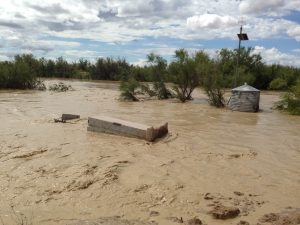
High-volume ephemeral flows, called flash floods, may move as sheet flows or sheetwash, as well as be channeled through normally dry arroyos or canyons. Flash floods are a major factor in desert deposition. Dry channels can fill quickly with ephemeral drainage, creating a mass of water and debris that charges down the arroyo, and even overflowing the banks. Flash floods pose a serious hazard for desert travelers because the storm activity feeding the runoff may be miles away. People hiking or camping in arroyos that have been bone dry for months, or years, have been swept away by sudden flash floods.
13.3.1 Sand
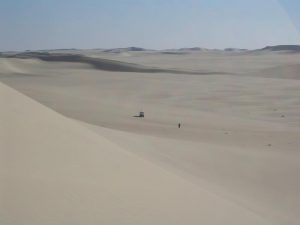
The popular concept of a typical desert is a broad expanse of sand. Geologically, deserts are defined by a lack of water and arid regions resembling a sea of sand belong to the category of desert called an erg. An erg consists of fine-grained, loose sand grains, often blown by wind, or aeolian forces, into dunes. Probably the best known erg is the Rub’ al Khali, which means Empty Quarter, of the Arabian Peninsula. Ergs are also found in the Great Sand Dunes National Park (Colorado), Little Sahara Recreation Area (Utah), White Sands National Monument (New Mexico), and parts of Death Valley National Park (California). Ergs are not restricted to deserts, but may form anywhere there is a substantial supply of sand, including as far north as 60° N in Saskatchewan, Canada, in the Athabasca Sand Dunes Provincial Park . Coastal ergs exist along lakes and oceans as well, and examples are found in Oregon, Michigan, and Indiana.
 An internal cross section of a sand dune shows a feature called cross bedding. As wind blows up the windward side of the dune, it carries sand to the dune crest depositing layers of sand parallel to the windward (or “stoss”) side. The sand builds up the crest of the dune and pours over the top until the leeward (downwind or slip) face of the dune reaches the angle of repose, the maximum angle which will support the slip face. Dunes are unstable features and move as the sand erodes from the stoss side and continues to drop down the leeward side covering previous stoss and slip-face layers and creating the cross beds. Mostly, these are reworked over and over again, but occasionally, the features are preserved in a depression, then lithified. Shifting wind directions and abundant sand sources create chaotic patterns of cross beds like those seen in Zion National Park of Utah.
An internal cross section of a sand dune shows a feature called cross bedding. As wind blows up the windward side of the dune, it carries sand to the dune crest depositing layers of sand parallel to the windward (or “stoss”) side. The sand builds up the crest of the dune and pours over the top until the leeward (downwind or slip) face of the dune reaches the angle of repose, the maximum angle which will support the slip face. Dunes are unstable features and move as the sand erodes from the stoss side and continues to drop down the leeward side covering previous stoss and slip-face layers and creating the cross beds. Mostly, these are reworked over and over again, but occasionally, the features are preserved in a depression, then lithified. Shifting wind directions and abundant sand sources create chaotic patterns of cross beds like those seen in Zion National Park of Utah.
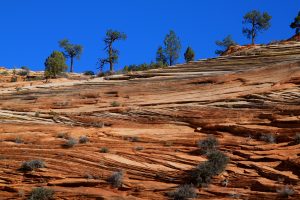
In the Mesozoic Era, Utah was covered by a series of ergs, with the thickest being in Southern Utah, which lithified into sandstone (see Chapter 5). Perhaps the best known of these sandstone formations is the Navajo Sandstone of Jurassic age. This sandstone formation consists of dramatic cliffs and spires in Zion National Park and covers a large part of the Colorado Plateau. In Arches National Park, a later series of sand dunes covered the Navajo Sandstone and lithified to become the Entrada Formation also during the Jurassic. Erosion of overlying layers exposed fins of the underlying Entrada Sandstone and carved out weaker parts of the fins forming the arches.

As the cements that hold the grains together in these modern sand cliffs disintegrate and the freed grains gather at the base of the cliffs and move down the washes, sand grains may be recycled and redeposited. These Mesozoic sand ergs may represent ancient quartz sands recycled many times from igneous origins in the early Precambrian, just passing now through another cycle of erosion and deposition. An example of this is Coral Pink Sand Dunes State Park in Southwestern Utah, which contains sand that is being eroded from the Navajo Sandstone to form new dunes.
Dune Types
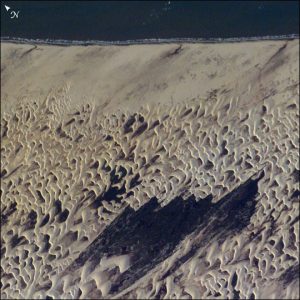
Dunes are complex features formed by a combination of wind direction and sand supply, in some cases interacting with vegetation. There are several types of dunes representing variables of wind direction, sand supply and vegetative anchoring. Barchan dunes or crescent dunes form where sand supply is limited and there is a fairly constant wind direction. Barchans move downwind and develop a crescent shape with wings on either side of a dune crest. Barchans are known to actually move over homes, even towns.
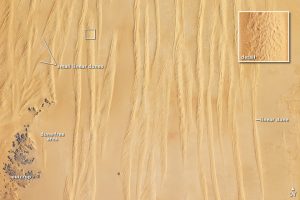
Longitudinal dunes or linear dunes form where sand supply is greater and the wind blows around a dominant direction, in a back-and-forth manner. They may form ridges tens of meters high lined up with the predominant wind directions.
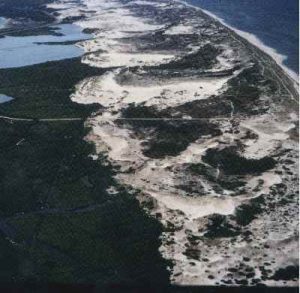
Parabolic dunes form where vegetation anchors parts of the sand and unanchored parts blowout. Parabolic dune shape may be similar to barchan dunes but usually reversed, and it is determined more by the anchoring vegetation than a strict parabolic form.
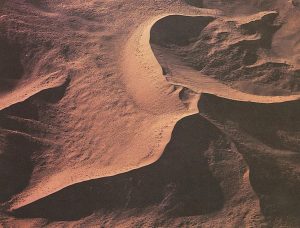
Star dunes form where the wind direction is variable in all directions. Sand supply can range from limited to quite abundant. It is the variation in wind direction that forms the star.
[ays_quiz id=”84″]
13.4 The Great Basin and the Basin and Range
![Source: By Kmusser [<a href="http://creativecommons.org/licenses/by-sa/3.0">CC BY-SA 3.0</a>], <a href="https://commons.wikimedia.org/wiki/File%3AGreatbasinmap.png">via Wikimedia Commons</a> Map of the Great Basin occupying Utah west of the Wasatch Mountains, most of Neada, southeast Oregon and esxtending into southern California.](https://opengeology.org/textbook/wp-content/uploads/2016/07/13.24_Greatbasinmap-268x300.png)
![Source: <a href="https://en.wikipedia.org/wiki/User:Qfl247" class="extiw" title="en:User:Qfl247">Matt Affolter (QFL247)</a> [<a href="http://creativecommons.org/licenses/by-sa/3.0">CC BY-SA 3.0</a> or <a href="http://www.gnu.org/copyleft/fdl.html">GFDL</a>], <a href="https://commons.wikimedia.org/wiki/File%3ARidgecrestCA.JPG">via Wikimedia Commons</a> The desert has a small town](https://opengeology.org/textbook/wp-content/uploads/2016/07/RidgecrestCA-300x200.jpg)
A journey from the Wasatch Front southwest to the Pacific Ocean will show stages of desert landscape evolution from the fault block mountains of Utah with sharp peaks and alluvial fans at the mouths of canyons, through landscapes in Southern Nevada with bajadas along the mountain fronts, to landscapes in the Mojave Desert of California with subdued inselbergs sticking up through a sea of coalesced bajadas. These landscapes illustrate the evolutionary stages of desert landscape development.
13.4.1 Desertification
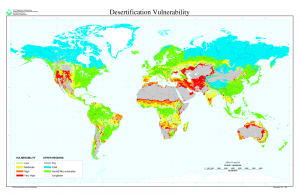
When previously arable land suitable for agriculture transforms into desert, this process is called desertification. Plants and humus-rich soil (see Chapter 5) promote groundwater infiltration and water retention. When an area becomes more arid due to changing environmental conditions, the plants and soil become less effective in retaining water, creating a positive feedback loop of desertification. This self-reinforcing loop spirals into increasingly arid conditions and further enlarges the desert regions.
Desertification may be caused by human activities, such as unsustainable crop cultivation practices, overgrazing by livestock, overuse of groundwater, and global climate change. Human-caused desertification is a serious worldwide problem. The world map in the figure above shows what areas are most vulnerable to desertification. Note the red and orange areas in the western and midwestern regions of the United States, which also cover large areas of arable land used for raising food crops and animals. The creation of the Dust Bowl in the 1930s (see Chapter 5) is a classic example of a high-vulnerability region impacted by human–caused desertification. As demonstrated in the Dust Bowl, conflicts may arise between agricultural practices and conservation measures. Mitigating desertification while allowing farmers to make a survivable living requires public and individual education to create community support and understanding of sustainable agriculture alternatives.
[ays_quiz id=”85″]
Summary
Approximately 30% of Earth’s surface is arid lands, the location of which is determined by latitude, atmospheric circulation, and terrain. The arid belts between 15o and 30o north and south latitudes are produced by descending air masses associated with major cells in the atmosphere and include the major deserts like the Sahara in Africa and the Middle East and central Australia. Rain shadow deserts lie behind mountain ranges or long land expanses in zones of prevailing winds like the deserts of western North America, the Atacama of South America, and the Gobi of Asia. Dry descending air also creates the polar deserts at the poles.
Major atmospheric circulation involves the Hadley cells, midlatitude or Ferrel cells, and the polar cells in each hemisphere. Warmed and rising air in the Hadley cells rains back on the tropics and moves toward the poles as dryer air. That air meets the dryer equatorward moving air of the Ferrel cells. This dry air descends in the arid zones, called the horse latitudes, to produce the arid belts in each hemisphere. Rotation of the Earth creates the Coriolis Effect that deflects these moving air masses to produce zones of prevailing winds, the Trade Winds in the subtropics and the Westerlies in the midlatitudes. A combination of latitude, rain shadow, and cold adjacent ocean currents causes the Atacama Desert of northern Chile, the driest desert on Earth.
Weathering in deserts takes place just as in other climes only slower because of less water. Desert varnish is a weathering product unique to desert environments. As in more humid climes, water is the main agent of erosion although wind is a notable agent. Large dust storms called haboobs transport large amounts of sediment that may accumulate in sand seas called ergs or finer grained loess deposits. Sand transport occurs mainly by saltation in which grain to grain impact causes frosting of grain surfaces. Sandblasting by persistent winds produces stones with polished surfaces called ventifacts and sculpted bedrock features called yardangs.
Landforms produced in desert environments include alluvial fans, bajadas, inselbergs, and playas. Windblown sand can accumulate as dunes. The forms of dunes, like barchans, parabolic, longitudinal, and star dunes, relate to the abundance of sand supply and wind direction as well as presence of vegetation. The internal structure of dunes shows cross bedding. Fossil dunes in an ancient desert leave cross bedding in places like Zion and Arches national parks in Utah showing shifting wind directions in these ancient environments. Ephemeral streams in desert regions may carry water only after storms and pose risk of flash floods.
The Great Basin of North America is an enclosed basin with no drainage to the ocean. The only exit for precipitation there is by evaporation. Travels in the Great Basin show stages of development of desert landscapes from playas and alluvial fans, to bajadas, to inselbergs which are eroded mountains buried in their own erosional debris.
Poor land management can result in dying vegetation and loss of soil moisture producing an accelerating process of desertification in which once productive land is degraded into unproductive desert. This is a serious worldwide problem.
[ays_quiz id=”86″]
References
- Bagnold, R. A. 1941. “The Physics of Blown Sand and Desert Dunes.” Methum, London, UK, 265.
- Boggs, Sam. 2006. “Principles of Sedimentology and Stratigraphy.” Pearson Prentice Hall. http://agris.fao.org/agris-search/search.do?recordID=US201300110702.
- Clements, Thomas. 1952. “Wind-Blown Rocks and Trails on Little Bonnie Claire Playa, Nye County, Nevada.” Journal of Sedimentary Research 22 (3). Society for Sedimentary Geology. http://archives.datapages.com/data/sepm/journals/v01-32/data/022/022003/0182.htm.
- Collado, Gonzalo A., Moisés A. Valladares, and Marco A. Méndez. “Hidden Diversity in Spring Snails from the Andean Altiplano, the Second Highest Plateau on Earth, and the Atacama Desert, the Driest Place in the World.” Zoological Studies 52 (1): 50.
- Easterbrook, Don J. 1999. Surface Processes and Landforms. Pearson College Division.
- Geist, Helmut. 2005. The Causes and Progression of Desertification. Ashgate Aldershot.
- Grayson, Donald K. 1993. The Desert’s Past: A Natural Prehistory of the Great Basin. Smithsonian Inst Pr.
- Hadley, Geo. 1735. “Concerning the Cause of the General Trade-Winds: By Geo. Hadley, Esq; FRS.” Philosophical Transactions 39 (436-444). The Royal Society: 58–62.
- Hartley, Adrian J., and Guillermo Chong. 2002. “Late Pliocene Age for the Atacama Desert: Implications for the Desertification of Western South America.” Geology 30 (1). geology.gsapubs.org: 43–46.
- Hedin, Sven Anders. 1903. Central Asia and Tibet. Vol. 1. Hurst and Blackett, limited.
- Hooke, Roger Leb. 1967. “Processes on Arid-Region Alluvial Fans.” The Journal of Geology 75 (4). journals.uchicago.edu: 438–60.
- King, Lester C. 1953. “CANONS OF LANDSCAPE EVOLUTION.” Geological Society of America Bulletin 64 (7). gsabulletin.gsapubs.org: 721–52.
- Kletetschka, Gunther, Roger Leb Hooke, Andrew Ryan, George Fercana, Emerald McKinney, and Kristopher P. Schwebler. 2013. “Sliding Stones of Racetrack Playa, Death Valley, USA: The Roles of Rock Thermal Conductivity and Fluctuating Water Levels.” Geomorphology 195 (August). Elsevier: 110–17.
- Laity, Julie E. 2009. “Landforms, Landscapes, and Processes of Aeolian Erosion.” In Geomorphology of Desert Environments, edited by Anthony J. Parsons and Athol D. Abrahams, 597–627. Springer Netherlands.
- Littell, Eliakim, and Robert S. Littell. 1846. Littell’s Living Age. T.H. Carter & Company.
- Livingstone, Ian, and Andrew Warren. 1996. Aeolian Geomorphology: An Introduction. Longman.
- Muhs, Daniel R., and E. A. Bettis. 2003. “Quaternary Loess-Paleosol Sequences as Examples of Climate-Driven Sedimentary Extremes.” Special Papers-Geological Society of America. Boulder, Colo.; Geological Society of America; 1999, 53–74.
- Norris, Richard D., James M. Norris, Ralph D. Lorenz, Jib Ray, and Brian Jackson. 2014. “Sliding Rocks on Racetrack Playa, Death Valley National Park: First Observation of Rocks in Motion.” PloS One 9 (8). journals.plos.org: e105948.
- Shao, Yaping. 2008. Physics and Modelling of Wind Erosion. Springer Science & Business Media.
- Stanley, George M. 1955. “ORIGIN OF PLAYA STONE TRACKS, RACETRACK PLAYA, INYO COUNTY, CALIFORNIA.” Geological Society of America Bulletin 66 (11). gsabulletin.gsapubs.org: 1329–50.
- Walker, Alta S. 1996. “Deserts: Geology and Resources.” Government Printing Office. https://pubs.er.usgs.gov/publication/7000004.
- Wilson, Ian Gordon. 1971. “Desert Sandflow Basins and a Model for the Development of Ergs.” The Geographical Journal 137 (2). [Wiley, Royal Geographical Society (with the Institute of British Geographers)]: 180–99.
